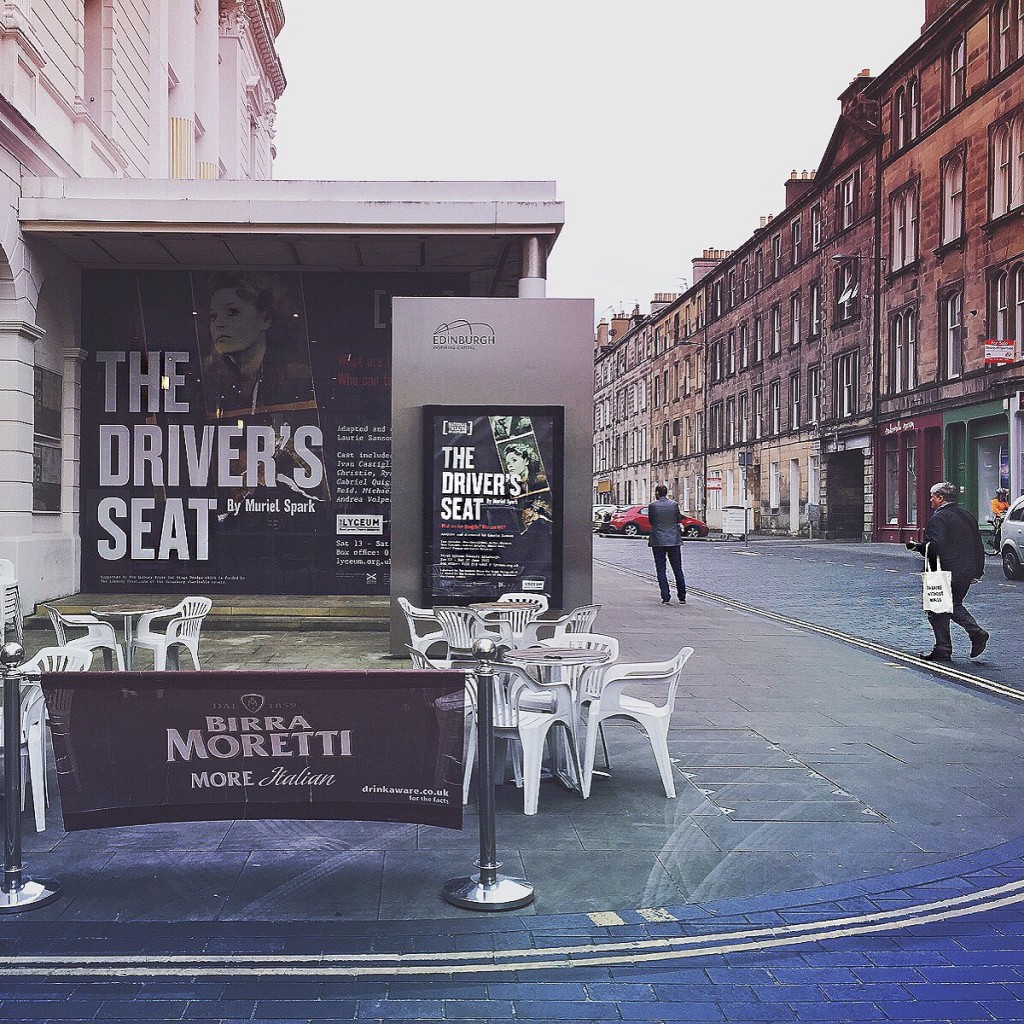Asking for It
I never thought I’d describe a rape-and-murder play as safe. I’d be lying if the very notion of such a careless thought didn’t provoke my feminist hackles. This is not a review in the traditional sense, just as the work is not a crime piece as you’d recognize it. There will be spoilers. There will be musings. I’ll tell you why I didn’t ‘like’ it (such a loose word for the arts) but that you should go anyway. Just as The Driver’s Seat is a whydunnit, this piece is a whyseeit. It’s often a far better catalyst than enjoyment, because it will yank critique from you in a way the simply good never can.
The Driver’s Seat is a weird book. Short, menacing, bleakly comical and laced with Muriel Spark’s twisted imprint. It’s an inside-out noir, telling the story of Lise – a woman in her thirties taking her last vacation whilst slipping into madness. The play – like the narrative – leaps around and deliberately misleads. Spoiler: she dies. Murder. We’re told this early, so you spend the rest of the piece playing Poirot. Laurie Sansom (of previous Jean Brodie success) is clearly fascinated by the audience as inquisitor. But I want you to go beyond the who and the why, and ask how and to what end.
This is a study of feminine madness. A stanchion of literature, celluloid and stage, yet often handled with a serious deficit of grace and understanding. Too often mad women are superficial narrative props. Sometimes to feed our creepy hunger to watch the last dance of tragic women. Sometimes to deepen the mystique of a female character by adding a kooky edge. Often both. Written in the 70s, The Driver’s Seat wrestles with the idea of insanity but is stained by its time. A contemporary reimagining of the subject for stage teems with possibility. This is precisely what made The Driver’s Seat such a frustrating piece of theatre.
Lise glissades across the stage in candy-cane clothes careering between control and abandon, without quarrying into either. This retelling falls victim to our Hollywooding of mental breakdown. She inverts laughter, she utters strange things, yet she seems restrained. This is a work that courts the elusive sum of gender and madness, and paints a pastiche of both. Our morbid fascination with disturbed women thrills because the properties of madness – the odd behavior, the outbursts, the jarring speech – all defy the expectations of perceived womanhood. Madness is often limned as a total loss of control. Of the disintegration of agency – this basic premise is what makes The Driver’s Seat so interesting. Agency is all.
“It’s a whydunnit in q-sharp major and it has a message: never talk to the sort of girls that you wouldn’t leave lying about in your drawing room for the servants to pick up.”
This is a story of courtship, but not of love. Lise entices and pursues her ‘type’ for a single grim proclivity. It depicts a mercurial heroine unraveling at the seams, but enacting the ultimate deliberate act: orchestrating her own murder. She leaves a Hansel and Gretel imprint of oddness on the people she meets. She lies. She pretends. She fluidly slips into other identities. Her garish clothes scream as loud as the personal ephemera she deliberately scatters. Lise wants to be noticed. Lise is deliberately mapping her end for you to see and remember. This is a denouement at her own hand, jagged with feminism. This takes the concept of ‘asking for it’ and wickedly subverts it.
Yet this theatrical imagining isn’t contemporary. It hobbles itself with the same dated misrepresentation of women we’ve seen in screeds of artistic imaginings. It gloms onto the safety of an established portrait of madness. It lingers on deviance and crescendos with a limp, predictable passivity that contaminates female protagonists across the arts. When we appeal to the deliciousness of schadenfreude, we suffocate discourse on what it actually means to be mad.
On the surface, this play is beautiful. It ticks the boxes of a great bit of theatre – the clever set, playful technical overlays, the understated and eerie sound design. Add in a talented cast, a provocative text and exacting production and you’re surely on the way to a winner. But put a former madwoman in a fold-down seat and she’ll see something she doesn’t recognize. An idealization of the obscure. A mawkish madness that makes the room erupts in rapturous applause but neglects a voice of authenticity.
This is precisely why you should see it. Our idea of insanity is so entrenched in our culture that we allow tropes to pass unchallenged. They unconsciously colour our ideas of madness and push us further from understanding. This is superficially triumphant, but devoid of the cerebral. In 2015 we cannot continue to use gender + madness as a selling point, without any attempt at insight into either.
So buy a ticket. Watch this elegant thing, but don’t rest on it being a night at the theatre. Use this as first, delicate step in questioning the world around you. Read The Yellow Wallpaper. Read The Bell Jar. Cry over Jean Rhys’s retelling of Bertha Mason as the madwoman in the attic. Consume it and question it. Until we start pulling at the indulgently tragic portrayal of women, we’ll never see anything real. Flickers of reality are what elevate the good-enough to the glorious.
The Driver’s Seat, Royal Lyceum Theatre, Edinburgh, June 13-27; Tramway, Glasgow July 2-4


Interesting review.